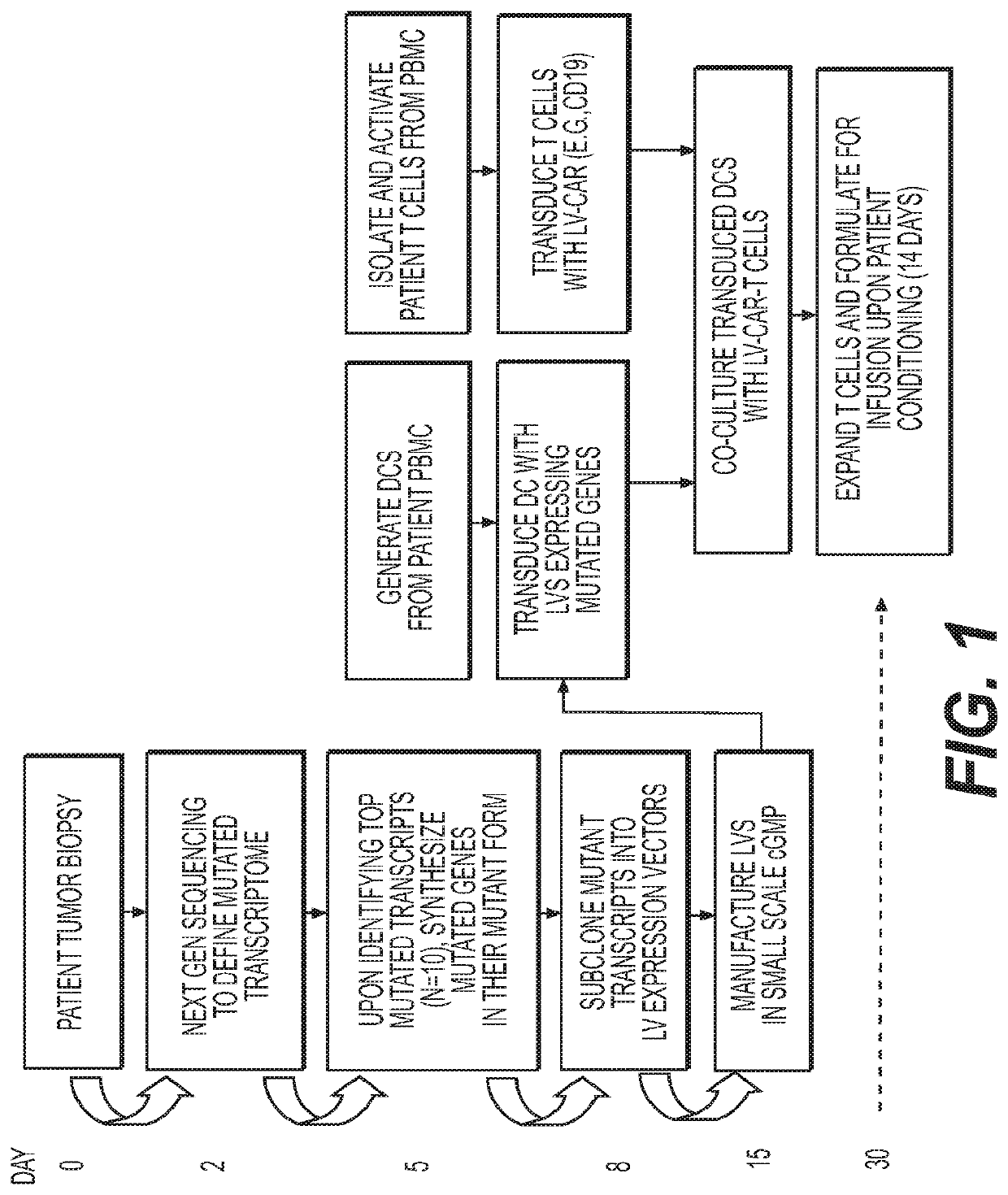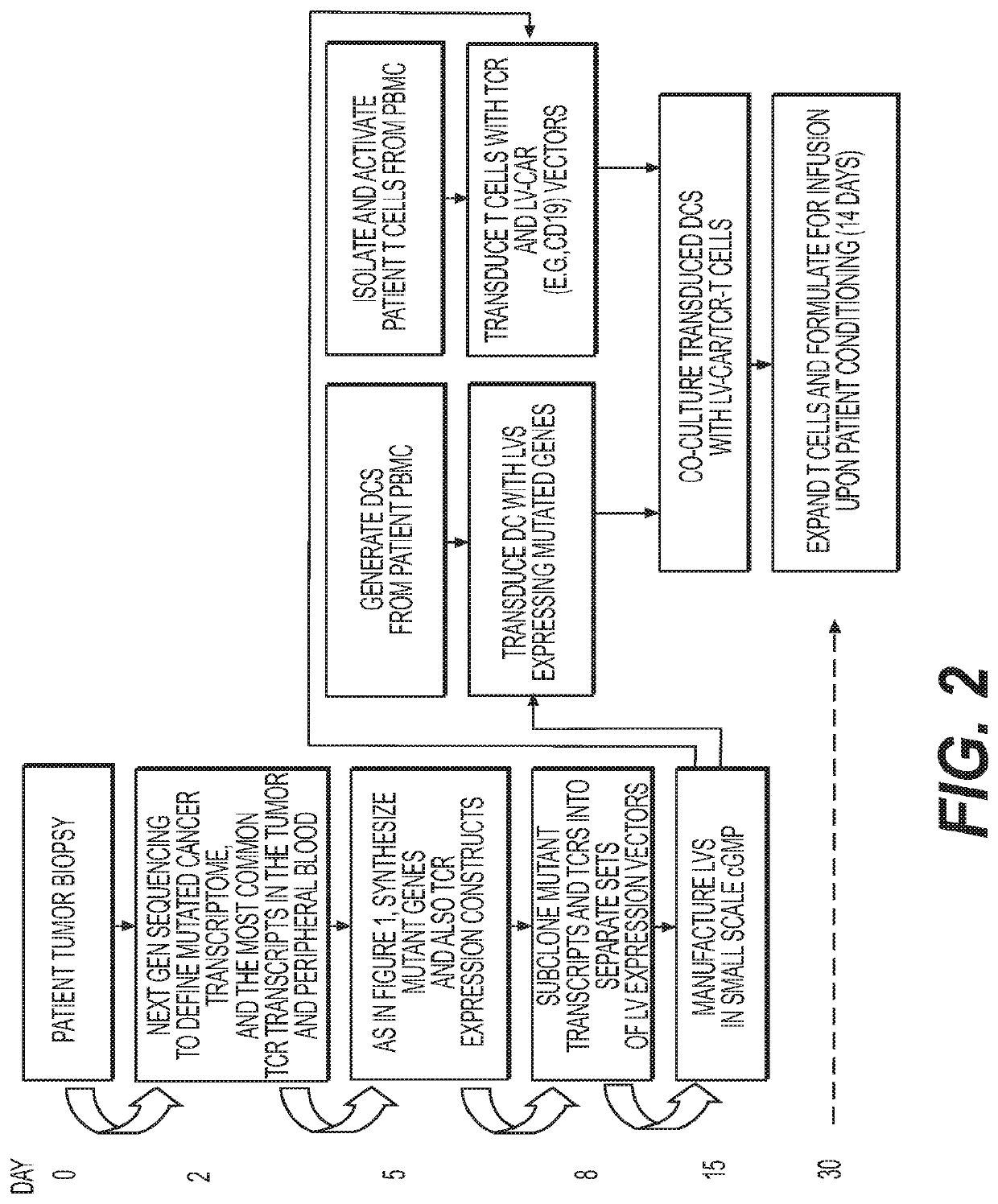Method to Treat Cancer with Engineered T-Cells
a technology of t-cells and cancer, applied in the field of cancer, can solve the problems of patient's tumor growth unimpeded, difficult treatment, and elapsed time between treatments,
- Summary
- Abstract
- Description
- Claims
- Application Information
AI Technical Summary
Benefits of technology
Problems solved by technology
Method used
Image
Examples
example 1
Next Gen Sequencing of the Tumor Mutanome
[0264]This procedure refers to Next Gen sequencing of patient tumor material, and identifying the mutated proteins present in the tumor (as a group, referred to as the mutanome). These sequences will be used as the basis for creating vectors that express mutant tumor proteins. When available, non-tumor-associated patient material will be used for normal comparison (such as peripheral blood), as will publically available databases of the human genome). The methods of Next Generation sequencing are a well-established technique in molecular biology and may be found, for example, in Vogelstein B, Papadopoulos N, Velculescu V E, et al., 2013, Cancer Genome Landscapes, Science 339:1546-1558.
[0265]The National Institutes of Health (NIH) has provided on-line the Cancer Genome Atlas (cancergenome.nih.gov). Therein can be found comprehensive maps of the key genomic changes in 33 types of cancer. The data is pipelined to the NIH through specific TCGA (T...
example 2
Next Gen Sequencing of TCRs
[0267]The procedure refers to using sequencing techniques to define the full complement of T cell receptors in a biological sample. The material analyzed will include patient tumor, in which case we will be describing the TCRs present in the tumor. In the peripheral blood, we will be describing the common TCRs present, some of which will be tumor specific. Next Gen sequencing allows the frequency of specific TCRs to be quantified. The application of next generation sequencing to identifying specific pairs of TCR alpha and beta chains is a well-established technique in molecular biology (Dash P, Wang G, Thomas P, 2015, Single-cell analysis of T-cell receptor AB repertoire, in Immunosenecense: Methods and Protocols, Shaw A C (ed.), Methods in Molecular Biology, vol. 1343, Springer Science+Business Media, New York.).
[0268]A multiplicity of approaches have been developed using current techniques of molecular biology, including the continued developments in aut...
example 3
Creation of Lentiviral Vectors Expressing the Tumor Mutanome
[0271]To confer expression of the mutanome to antigen presenting cells, patient-derived antigen presenting cells, a non-limiting example being dendritic cells, lentiviral vectors (LV) were used to encode the ten (ten is an approximation and the number of LVs can vary from 1 to 100) most predominant mutant proteins present in the mutanome. The LVs can encode a mutanome containing the relevant epitopes or individually clone each mutated gene into a multiplicity of LVs. The DCs can also be transduced with other genes or non-coding RNA to enhance the effect of producing highly functional DCs and / or T cells. Non-limiting examples of such genes or non-coding RNA are IL-2, IL-4, IL-12, IL-17, IL-15, IL-21, IL-7, IL-4, GM-CSF. miR 21, miR221, and miR142-T. They were also transduced with such proteins so that they facilitate monocyte to DC differentiation, and then switch off once differentiation has occurred by using tissue specifi...
PUM
| Property | Measurement | Unit |
|---|---|---|
| survival rate | aaaaa | aaaaa |
| temperatures | aaaaa | aaaaa |
| purity | aaaaa | aaaaa |
Abstract
Description
Claims
Application Information
 Login to View More
Login to View More - R&D
- Intellectual Property
- Life Sciences
- Materials
- Tech Scout
- Unparalleled Data Quality
- Higher Quality Content
- 60% Fewer Hallucinations
Browse by: Latest US Patents, China's latest patents, Technical Efficacy Thesaurus, Application Domain, Technology Topic, Popular Technical Reports.
© 2025 PatSnap. All rights reserved.Legal|Privacy policy|Modern Slavery Act Transparency Statement|Sitemap|About US| Contact US: help@patsnap.com


